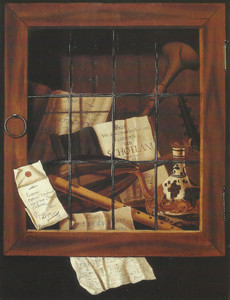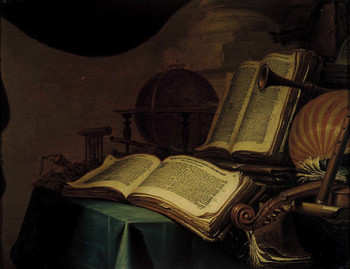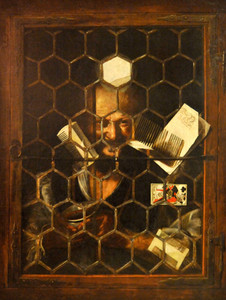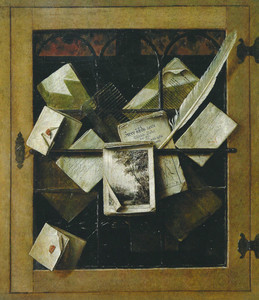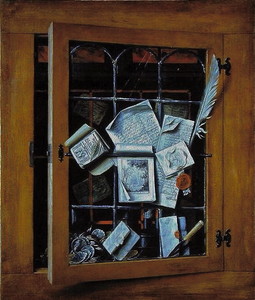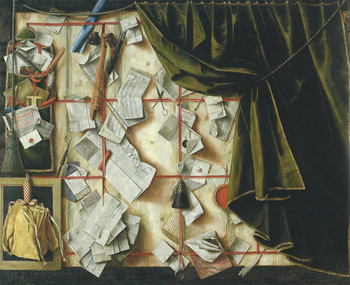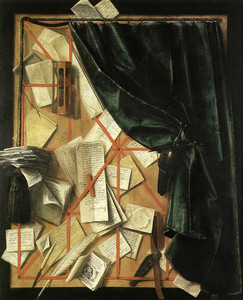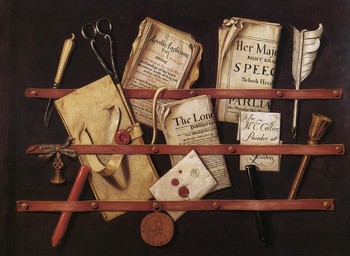Edwaert Collier
Trompe l’oeil
Oil on canvas : 51,5 X 63,7 cm
Unsigned
Circa 1702
London, Victoria and Albert Museum
This is a comparative item
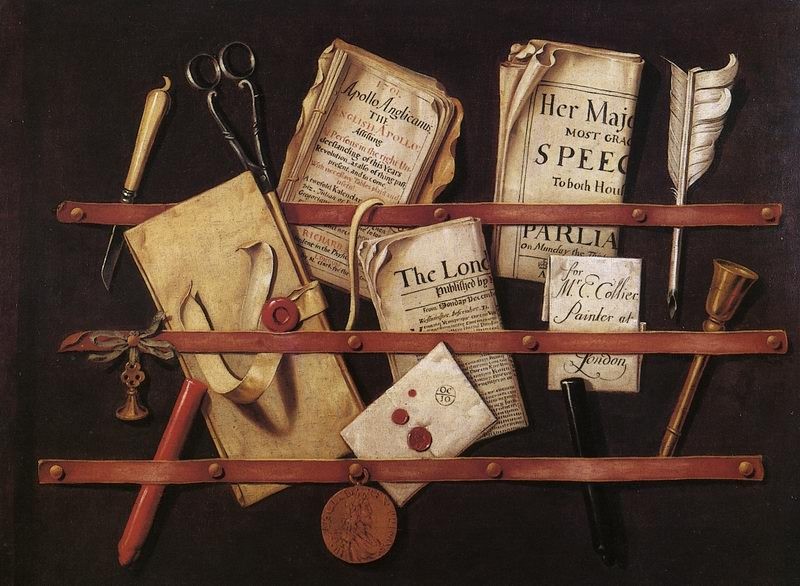
Painting for Sale
In short
Apart from this trompe l’oeil there is only one more painting known by this Dutch painter; both paintings date from the 1660s. It is not known which name his initials stand for. Each painting shows a refined composition, a view of a leaded window of a cupboard with letters and objects. Judging by the content of the letters our painter might have been active in The Hague and/or Breda.
About Master “PS”
I would like to thank Fred Meijer who has linked our painting to a trompe l’oeil still life signed “PS” and dated 1663. That painting had originally been sold as by Jan Vermeulen, active around the middle of the 17th century in Haarlem. When it re-appeared onto the market it was discovered that it was dated “1663” and that there were traces of a worn signature “P***S***”. According to Fred Meijer that painting and ours are the only ones known by this artist until now.
About the art of painting a “trompe l’oeil”
A “trompe l’oeil” is a convincing optical illusion, a game, a manipulative joke, a cheating device. Painting also: how can a painter represent in two dimensions the effect of depth, of a third dimension? How far would these painters go in playfully excelling in their art? How refined could culture get? Painters turned art into a game and a game into art.
These paintings were called “bedriegertjes” in Dutch, that is “a small imposter, a small crook”. Their aim was not only to deceive by perfectly imitating the objects, but also to be identified as painted fiction.
Plato wrote that “everything that deceives may be said to enchant”. In the world of arts this idea is almost self-evident: the artist transforms paint into his or her perception of the world. The very fact that this version of reality is subjective forms the essence of its attraction to the viewer.
In his “Naturalis Historia” (Natural History), the Roman author Pliny the Elder (23 AD – 79 AD) tells the story of a competition between the 5th century BC Greek painters Zeuxis of Heraclea and Parrhasius of Ephesus (who settled in Athens).
Zeuxis painted a bunch of grapes so real that birds flew down to peck at the painting. Confident of his success, Zeuxis asked Parrhasius to draw back the curtain covering his work, only to realise that the curtain itself was the painting, a painted illusion, and that Parrhasius had won the competition.
Around the middle of the 17th century trompe l’oeil painting as a seperate genre appeared in Dutch and in Flemish art. Soon its prodigal specialists became sought-after artists, not only in the Low Countries but all over Europe: Samuel van Hoogstraten worked in Vienna, Rome and Dordrecht; Cornelis Norbertus Gysbrechts worked in Copenhagen (where the Statens Museum holds a magnificent collection of him) and Stockholm; Edwaert Collier worked in London.
About our painting
Master “PS” painted here a trompe l’oeil still life of the closed leaded window of a cupboard with a partially drawn back curtain revealing several letters, a pocket watch and a magnificent jug.
The idea of a composition holding illusionistically painted letters and slips of paper goes back to the late 15th century letter rack by Vittore Carpaccio (J. Paul Getty Center in Los Angeles).
Credits for this new fashion around the middle of the 17th century in Holland should be given to Samuel van Hoogstraten. He painted very diverse trompe l’oeil paintings:
- letter racks in which letters and very diverse objects are depicted on a vertical board behind horizontally, vertically or diagonally attached red tapes;
- a variety of this theme were leaded windows with similar letters and objects, sometimes in combination with a portrait.
Paintings of this kind are sometimes called “Quodlibet”, which in latin means “what you please” or “anything at all”.
Our painter, whom we know only one other very refined composition of, chose twice for a leaded window, apparently of a cupboard holding letters and objects. The musical instruments in the painting from 1663 might symbolise the emptiness of earthly pleasures, while our pocket watch stands for transcience.
In our painting Master “PS” has added a furhter trompe l’oeil element, a curtain, that has been seemingly pulled aside. The Flemish painter Cornelis Norbertus Gysbrechts regularly used this device: not only does it enforce the cheating effect of the trompe l’oeil, it is also an intelectual reference to the story of Zeuxis told by the Roman author Pliny the Elder.
Why should you buy this painting?
Because it is an early example from the 1660s of an art form that became popular all over Europe in the second half of the 17th and the early 18th century.
Comparative paintings
Click photos for more details

